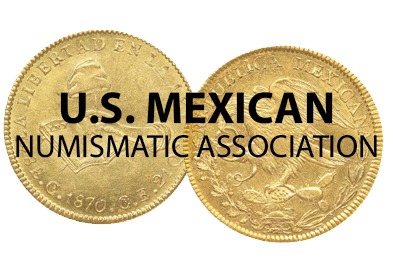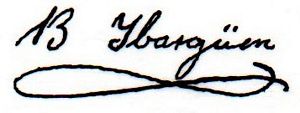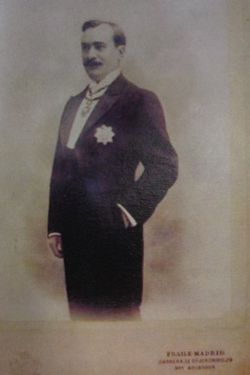Signatories of the Banco Mercantil de Veracruz
Gerente
Interventor
|
José Mirón y Mosquera was a shareholder in the oldest casa comercial in Veracruz, Viya Hermanos Sucesores, originally founded in 1770. He was appointed interventor on 5 January 1897CEHM, Fondo CDLIV Colección José Y. Limantour, 1a. 1883, carpeta 35, legajo 9320. |
  |
Consejero
|
Esteban J. Pous was a merchant in Veracruz who invested his profits in several sectors of the economy (trade, banking and urban goods) and in urban and rural real estate. He owned three properties known as El Zapotal, Durazno and Palo Miguel, in San Juan Evangelista, Minatitlán and La Rinconada, located in the municipality of Puente Nacional. Pous was vice-president of the bank in 1899 and when he died in June 1903. |
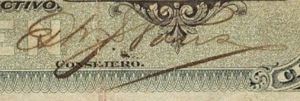 |
|
In addition to being a shareholder and manager of Zaldo Hermanos y Compañía and a founding shareholder and president of the Banco Mercantil de Veracruz, he was a director of the Banco Hispano Americano, director of the Tabacalera Mexicana, S. A.La Tabacalera Mexicana was established in 1899 as Basagoiti, Zaldo y Compañía, to set up a cigarette factory. Zaldo Hermanos y Compañía had 25% of the stock (Antonio Basagoiti had another 25%). It was reorganised in 1907 as La Tabacelera Mexicana S. A. and vice-president of the Círculo Español Mercantil of Veracruz. For his efforts in raising funds for Spain in the Cuban war of independence Anselmo was awarded the Cruz del Mérito Naval and the Collar de la Real Distinguida Orden de Carlos III and Comendador de la Real Orden de Isabel la Católicainformation on the Zaldo family from Rafael Zaldo Hernández, Indianos Ilustres: Familia Zaldo, México, 2013. |
 |
|
Dionisio Román Zaldo was Anselmo’s brother. He was born in Pradoluengo, Burgos, Spain on 21 May 1878. As well as being a director of the Banco Mercantil de Veracruz, he was president of the Banco de Tabasco, S. A., a shareholder and manager of Zaldo Hermanos y Compañía, director of the Tabacalera Mexicana, S. A. and of the Compañía Petrolera Cuauhtémoc, S. A. and president of the Iberia football team. He was president of the Círculo Español Mercantil of Veracruz in 1913 – 1914. |
 |
|
Ricardo Zaldo was born in 1869 as the son of Bruno Zaldo. His company, Ricardo Zaldo, Hermanos y Compañía, acquired and operated the textile factory, La Fábrica Textilera de San Bruno, which had been established in Xalapa in 1852. In 1896 he became gerente of Zaldo Hermanos y Cía.Semana Mercantil, 6 January 1896 (Zaldo Hermanos y Cía morphed into Zaldo Hermanos y Cía, S. en C. in July 1904)El Correo Español, 2 July 1904. The socios comanditarios were Clemente and Gervasio Zaldo, and the gerentes Anselmo Román Zaldo, Dionisio Román Zaldo and Adolfo Espinosa y Espinosa. He was also a director of Almacenes Generales de Depósito de México y VeracruzThe Secretario de Hacienda Finance granted a concession for the formation of a bank to the Compañía Bancaria Anglo-Mexicana, the Banco Central Mexicano and the Banco Mercantil de Veracruz. In 1901 they created the Almacenes Generales de Depósito de México y Veracruz, unifying the interests of bank investors from the north of the country, the capital and the port of Veracruz. The company had warehouses at Veracruz for the purpose of receiving, storing and selling on commission goods of various kinds, both Mexican and foreign. The main function of this company was to enable the exchange of the banknotes of the banks of these regions, so that these circulated more widely, thus breaking the monopoly of the Banco Nacional de México in the national financial market. The share capital of $2,000,000 was subscribed as follows: Banco Mercantil de Veracruz 6,060 shares of $100, $606,000; Banco Central de México 3,330; Compañía Banquera Anglo-Méxicana 1,380; Voiney W. Foster 1,900; Lyndon H. Stevens 1,000; Enrique C. Creel 1,000; Banco Oriental de México 500; Guillermo Landa y Escandón 500; José María Bermejillo 50; Andrés Bermejillo 250;. Emilio Mavran 250; Ramón Alcazar 250; Walter M. Brodie 250; Carlos Casasús 250; F. O. Lowden 250; E. Thompson 250; Joaquín D. Casasús 250; H.R. McCullouch 200; José Castellot 200; Hugo Scherer 150; Ges G. Wilcox 100; Hugo Scherer (Jr) 100; Augusto Genin 100; Manuel Araoz 100; Gustar Bauman 100; Eugenio Gabarrot 100; Ricardo Zaldo 100; Albert V. Foster 100; Esteban J. Pons 100; Manuel Rivero Collada 100; Palomo y Cía 100; Paul Guma 100; Armando Deschamps 100; Anselmo Villacieros 100; E.D. Kenna 50; F. de Pimentel v Fagoaga 45; Genaro Raigosa 25; and Lorenzo Ramírez y Borgas 10. On 12 January 1905 he left Veracruz with a group of friends for his marriage in Torreón La Opinión, Veracruz, Tomo II, Núm 186, 13 January 1905 to Librada Arredondo Zepeda on the following SundayEl Correo Español, Año XVI, Núm. 4,544, 16 January 1905. He seems to have stayed in Veracruz until at least November 1906, when he was referred to as a ‘capitalista veracruzano’El Diario, 8 November 1906 but at some stage moved to Torreón. In 1910 he was managing “El Puerto de Veracruz” thereEl Progreso de México, Año XVII, Núm. 800, 8 June 1910 and was elected tesorero of the Centro Español de la LagunaEl Correo Español, 11 November 1910. The presidente was Joaquín Serrano and the secretario Policarpo Suso. In 1910 he owned a clothing warehouse (almacen de ropa) called “El Telegrafo”, next to the Casino de la Laguna, and lost his stock in a fire in July 1910El Imparcial, 15 July 1910. On 4 December 1910 he was elected one of the regidores of TorreónEl Imparcial, 7 December 1910. Torreón favoured bankers as the other regidores were Mauro de la Peña, Ignacio Zaragoza, Francisco Larriva, José R. Castro, and Lázaro de la Garza and described as ‘an administrator of recognised ability’The Mexican Herald, 17 January 1911. His son, Manuel, was born in Torreón on 29 February 1912 (only one birthday every four years). When the Villistas took Torreón in October 1913 Zaldo’s clothing store was looted and then burntEl Diario, Año VIII, Núm. 2,020,18 October 1913, and he would have been driven out. In 1915 Zaldo was appointed a member of Carranza’s Comisión Interventora de La Laguna in Torreón. He died In Mexico City on 28 October 1946, at the age of 77. |
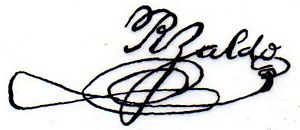 |
|
Ramón Marure Cano was a Spaniard from Valle de Ruesga, Spain. He ran a casa comercial in Veracruz. He died in Veracruz in June 1909. |
 |
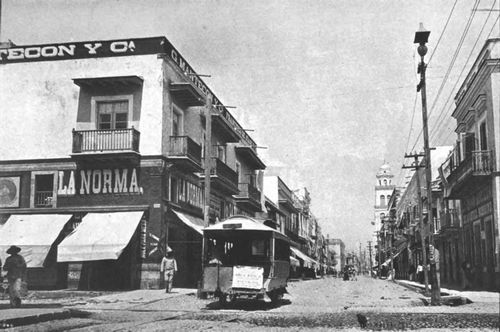
|
Andrés Armando Deschamps was a member of the political and commercial elite of Veracruz. His company was A. Deschamps y Cía, S. en C.Its members were Armando Deschamps himself as manager, Ricardo Zaldo and Mario Molina. The company was incorporated with a share capital of $45,000 and was created for the operation of "La Norma"., trading as "La Norma", located at Independencia 59 and offering everything related in haberdashery, clothing, luxury goods, silks and satins, and also shoes and boots for ladies and gentlemen. He was a member of the second Consejo Administrativo in 1899. Armando Deschamps was a founding member of the Cámara Nacional de Comercio in 1909. Because of his "proven honesty" he was appointed Tesorero General in 1915 and he was also substitute governor in 1919 and 1920. |
|
| Federico Gutiérrez y Pico was cajero of the bank when it opened. He joined the board on 11 June 1903 to fill the vacancy left by the death of Esteban PousAGN, SC224 Antiguos Bancos de Emisión, caja 295, libro [ ]). | 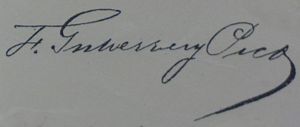 |
| Pedro González |  |
| Victoriano Llorente |  |
|
was president of the bank in 1900-1901 and 1909-1913 |
 |
|
By 1901 Adrian Carranza Escobar was manager of Calleja y Hnos. Cía, a firm founded in 1864, which was situated at Independencia 7 and offered domestic and imported groceries. He was also a board member of the Cervecería Moctezuma in Orizaba and the Ingenio San Cristóbal in Veracruz and, in December 1902, became the first president of the Compañía Banquera VeracruzanaThe Mexican Herald, Vol. XV, No. 95, 4 December 1902. In May 1908 Carranza was President of La Refinadora de Petróleo, S. en C.Veracruz Moderno, 9 May 1909. José María Pardo was Secretary and in April 1916 he was a founding member of the Unión Petrolera de Veracruz, S. A.El Pueblo, Año III, Tomo I, Núm. 531, 11 April 1916. Other founding members were Dionisio Roman Zaldo, Antonio G. de Presno, Carlos Muñoz, while Alfredo Sierra was Presidente. Carranza moved to Guadalajara, where he died on 26 November 1927El Informador, Año XI, Núm. 3,655, 27 November 1927. |
 |
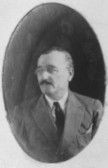 Laureano Alvarez García was born in Gijón, Asturías, Spain around 1861. Laureano Alvarez García was born in Gijón, Asturías, Spain around 1861. |
 |
|
Alfredo Sierra was born in 1872. From 1 March 1901 he was manager of Casa C. Benito y CíaEl Correo Español, 17 March 1901 which ran “La Soriana”, at Vicario 8, offering lingerie, silks and fancy goods. In April 1916 he was president of the newly-formed Unión Petrolera de Veracruz, S. A.El Pueblo, Año III, Tomo I, Núm. 531, 11 April 1916. Other board members were Dionisio Román Zaldo, Carlos Muñoz and Antonio G. de Presno, and Adrián Carranza was an investor. |
 |
|
was president of the bank in 1901-1903. By July 1902 he was sole manager of C. Benito y Cía. and President of the Veracruz board of the Ingenio San Cristóbal. |
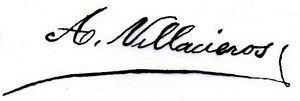 |
| Jacinto Villacieros Benito was another member of the Spanish community in Veracruz. |  |
| Carlos Muñoz | 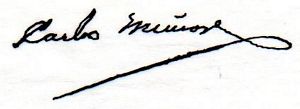 |
|
In 1906 Speckter was the socio gerente of the casa comercial, M. During y Cia., Sucs, S. en C.La Opinión, 20 July 1906. This casa commercial was founded in the 1860s by H. Von During and was situated in the Portales del Diligencias, facing the Plaza de Armas. It also had ten warehouses to store its stock of equipment and supplies for agriculture and coffee production, fence wire, electrical goods, paint, oil and varnishes. It also exported wood, coffee and tobacco, and besides Veracruz covered the states of Tabasco, Yucatán, Oaxaca, Guerrero and Chiapas. Speckter was consul for the Netherlands. |
 |
| C. Pardo y Sáinz |  |
| Antonio Palomo was the primer vocal propietario in 1899. | 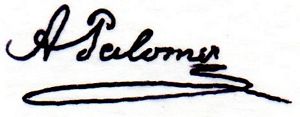 |
